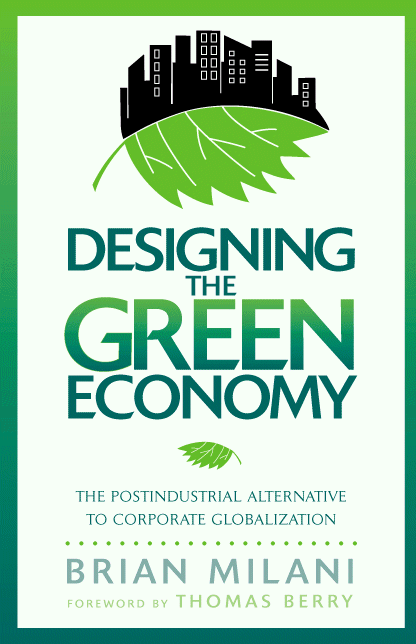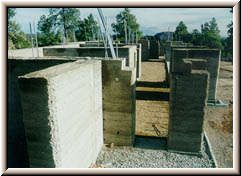|
Building Materials in a Green Economy |
 |
|
| Community-based Strategies for Dematerialization | ||
|
Building Materials in a Green Economy |
 |
|
| Community-based Strategies for Dematerialization | ||
![]() Brian
Milani, 2001
Brian
Milani, 2001
![]()
Paper delivered to the biennial
conference of the Canadian Society for Ecological Economics (CANSEE),
McGill University, Montreal, August 25, 2001.
Intro: Materials and Building
Service and the Ecological Economy
Elements of Material Solutions in Building
What is a Green Material?
Deconstructing the Waste Economy
Alternative Materials
Industrial Ecosystems
Rules, Regulation and Coordination
The Significance of Consumption
Prosumption in a Green Economy
Green Consumerism, Information and Markets
In Summary
References & Resources
Materials
are the stuff of economic life in our industrial
world. They include the resource inputs and the product outputs of
industrial production. How we handle them is a major determinant
of real economic efficiency, and also has a major impact on our health
and the health of the natural environment.
Although the
primary focus of popular environmental awareness has been on energy, it
is our relationship to materials that will probably have the most significance
for green economic transformation and the establishment of sustainable
societies. Over the past decade or so, green thinking has increasingly
recognized that minimal levels of sustainability depend on radical increases
of resource-efficiency—in the industrialized countries, by a factor of
ten. Such efficiency gains seem almost impossible in the current
system. But there are also fears that, even if major efficiency gains
could be made, they might easily be offset by continuing growth of the
economy as a whole (Gardner & Sampat, 1998; A. Hayden, 1999).
The technological
and organizational potential to successfully make these changes, however,
does exist. Cutting-edge thinking on green economics has associated
industrialism with material accumulation, and postindustrialism with what
has been called dematerialization
of the economy. The argument is that a growing role for knowledge,
information and culture should make it possible to displace materials and
energy with human intelligence and ingenuity. This would allow us
to satisfy more basic human needs with far fewer resources. It would
ostensibly also allow us to fit human economic activities within natural
processes without disrupting them. But all this would entail fundamental
changes in the form, content and driving forces of the economy—the subject
of my recent book, Designing
the Green Economy.
The
built-environment is also a strategic realm of social, economic and environmental
change. Various writers have stated that spatial redesign of the landscape
and built-environment may be the single most effective means of achieving
new levels of efficiency and sustainability (Lyle, 1994; Mollison, 1983;
Alexander, 1977; Van der Ryn & Cowan, 1996). Building materials
are also quite important. One reason is because of the weight and
volume they represent. They have been estimated to constitute up to 40
percent of the entire economy’s material throughput. It follows that changes
in building materials use can leverage major changes in manufacturing,
extraction and disposal.
Building materials
are also the stuff of our personal environments. They are all around
us, and literally part of the air we breathe. They can damage the
biosphere: VOCs from paints alone are responsible for perhaps 9 percent
of the damage to the ozone layer. They can also damage us: the US
Environmental Protection Agency (EPA), for example, estimates that indoor
pollution—caused by materials like paints, plastics and particleboards—is
responsible for more than 11,000 deaths each year from cancer, kidney failure,
and respiratory collapse (Ligon, 2001).
The fact that
buildings are all around us means not only that they immediately impact
us, but that we can potentially affect them. The building industry is a
decentralized one that exists in virtually every community. Not surprisingly,
the built-environment is a major venue for ecological and community development
alternatives, with materials being an increasing focus of concern over
the past decade.
The purpose
of this essay is to marry these concerns about materials and building,
and consider strategies for dematerialization in the building industry.
In particular I want to look at community-based initiatives, and consumption
as a starting point for transformation. Various writers and
catalysts like the UK’s Martin Charter (2001) have argued that it is more
effective to work on the level of production, where corporate decisions
can more directly affect supply chains, product designs and so on.
Others put the focus on regulation, insisting that the incentives and disincentives
structured into the economy are crucial. I will argue that a strategic
focus on end-use, consumption and community may be an ultimately more powerful
influence on both corporate action and state economic development policy.
Real dematerialization,
however, requires action on every level of production, consumption and
regulation, and there are pitfalls and limitations at every level—especially
consumption. Before looking at these, I will briefly survey some
of the key realms of building materials transformation, based on an understanding
of what an ecological economy can and should be—the perspective of an “ecological
service economy”. Hopefully this will provide some context for discussing
the role of consumption in catalyzing change, and especially through the
use of information in community-based initiatives.
Service
and the Ecological Economy
In Designing
the Green Economy, I highlighted ten key principles of green
economic development, but for the purposes of this essay, we can reduce
these to two primary aspects of the ecological economy. A green economy
is one in which (1) the primary focus
would be selling services rather than material products, and (2)
economic activities would be designed to either fit within, or mimic, the
closed-loop design of natural ecosystems.
The second
notion, while quite radical, is perhaps most easily understandable.
For decades green builders and designers have attempted to create buildings
and communities that work with nature rather than against it. More
recently they have begun to emphasize the use of local resources and materials—both
natural materials like earth and reclaimed materials from the waste stream.
At the same time, the perspective of industrial ecology has emerged to
spark the creation of manufacturing systems that mimic ecosystems.
The first green economic principle, that of selling services in the building industry, is perhaps not so straightforward. In fact, how it applies to most sectors of the economy might seem perplexing. The idea of selling services is actually a very radical concept. It refers NOT to the exporting of manufacturing to the Third World, but to a basic change in the aims of economic activity in every sector. It would transform all material output from being the end-goal of economic development into a simple means of meeting social and environmental need. These service-needs include nutrition, access (or mobility), health, entertainment, etc. Service is another way of describing “end-use”. As Amory Lovins (1977) initially described this approach to energy two decades ago, we should primarily be concerned with providing “hot showers and cold beer”, not power plants or fossil fuels. By focusing on the service-need desired, we can creatively discover the most elegant and efficient way (or ways) of meeting this need. Invariably this allows radical reductions in the amount of matter and energy used, and, more often than not, a much higher level of quality.
It is possible
to find examples of eco-service in the existing economy. For example,
there is the much-cited transformation of Xerox into a “document company”
that designs its hardware for disassembly and reuse. On the cutting
edge of green business, there is also Interface Flooring, which is voluntarily
implementing “extended producer responsibility” that drastically reduces
waste.
For the entire
economy, however, displacing production-for-production’s-sake with a service
approach is a much more difficult proposition. Capitalism has always
been based in growth and expansion. There is currently quite a debate
as to whether it is possible to completely disconnect monetary from material
accumulation. It amounts to a debate as to whether a “green” or “natural
capitalism” is possible, or whether the profit-motive itself must be replaced
with other indicators and incentives.
This essay isn’t the place to resolve that debate (although I do deal with it in my book). Whatever we choose to call an ecological economy, the point is that dematerialization and a focus on service-needs require wholesale changes in the rules of the game, and in longstanding economic incentives and disincentives. This requires a transformation in the form, content and driving forces of the economy. Industrial ecologists and green economists have made significant contributions in outlining the implications of a service approach in manufacturing. My particular concerns revolve around what the building industry would look like in an ecological service economy. To this end, I want to survey briefly the realms affected by a transformation of materials in building. Hopefully this will provide some context for a discussion of community action.
Elements
of Material Solutions in Building 
John Young (2000) recently summarized the hierarchy of materials efficiency that can be applied to construction materials with just a little qualification:
1. Materials use avoidance: this includes scrutiny of consumption needs themselves—do we really need to build this?—and voluntary simplicity. It includes a focus on selling services, rather than products. It also includes the redesign of products, buildings and settlements to dispense with superfluous materials. The great efficiencies resulting from ecological urban design and mixed-use development are in this category.
2. Increased intensity of product use: All kinds of sharing are included here, and thus there is some overlap with category #1. Co-housing developments with shared facilities, for example, can substantially reduce the volume of materials use.
3. Extended product life: Repair, reuse and remanufacturing are in this category, and in building there is vast potential for deconstruction (the disassembly of buildings) and the reuse of building materials. One step further is the design of buildings to be easily changed, repaired and disassembled.
4. Finally, there is materials recovery, or recycling. This tends to require more energy, but some form of recycling will be ultimately necessary for every material at a point in its life cycle, no matter how durable, reused, or shared it has been.
While this categorization is not sufficient in itself to deal with all the main dimensions of transforming materials use in construction, it provides a framework that can be built upon. We can add concerns of toxicity, human and ecosystem health, job creation and other aspects mentioned in product evaluation.
Key areas that are crucial to achieve this materials transformation are:
This
is an important question, and cannot be separated from the question of
how we can reduce the use of materials. In a sense, they are two
articulations of the same dilemma: how to understand, revalue and reorganize
flows in the economy.
A green material
is one that simultaneously does the most with the
least, fits most harmoniously within ecosystem
processes, helps eliminate the use of other
materials and energy, and contributes to the
attainment of a service-based economy.
Understanding
what a green material is depends on understanding relationships—in nature,
in the economy, between nature and the economy. It is a very complex
matter and always changing. What is considered a green material is
also constantly changing. It is certainly important to look closely
at every individual product and material, but it is often more efficient
to look first at the building system.
This is particularly clear when we see systems now being designed to allow
buildings to be easily dismantled rather than demolished. The context
in which a material is used is crucial. A conventional petrochemical-based
building material might be used in buildings and developments that are
quite ecological in overall impact. Similarly, a “green” material
might be deployed or installed in destructive ways that completely negate
their positive characteristics. By being salvaged and reused, a very
conventional material might become a green material. It’s a question of
relationships that are multi-dimensional and constantly shifting.
 Criteria
for evaluating building materials include the general categories of resources,
performance
and pollution. The resources
required
for a material can be consumed in extraction, production, use or disposal.
The same is true for pollution. Performance
refers to the energy and resources it can save or squander doing its use.
For each category of material, performance means something quite different.
For example, the performance of insulation must be judged mainly in terms
of its thermal resistance, while a floor tile would be evaluated more for
its durability.
Criteria
for evaluating building materials include the general categories of resources,
performance
and pollution. The resources
required
for a material can be consumed in extraction, production, use or disposal.
The same is true for pollution. Performance
refers to the energy and resources it can save or squander doing its use.
For each category of material, performance means something quite different.
For example, the performance of insulation must be judged mainly in terms
of its thermal resistance, while a floor tile would be evaluated more for
its durability.
Deciding what
is “green” is sometimes quite relative. Some products in a certain
category might be the greenest simply because the available alternatives
are so destructive (for example, CCA-treated wood or PVC plastic).
Even the best current directories of green building materials are often
forced to compare apples and oranges within the same category—for example,
comparing the energy-intensity of one product with the toxicity of another
(Wilson, 2000). The ideal of an objective numerical LCA rating for
every product and material will always be a distant dream. It should
be pursued, but evaluators, particularly those who synthesize available
data to help consumers make the best possible choices, will simply have
to do the best they can.
Here
are a number of criteria that have commonly been used in evaluating
building materials:
 Other
criteria can also be applied that stem from larger concerns about sustainability.
They can be social, political, ethical and even spiritual. What are
the working conditions for producers or installers of these materials?
What kind of labour is involved, skilled or unskilled? Do these materials
contribute to community development? Do they close gaps, or
make useful linkages, in the local economy? In some cases, a community
might have to make a tough choice between a high-tech energy-saving product
and a local low-tech traditional material that would create sustainable
livelihoods. If we are looking at materials from the perspective
of quality, society-wide, it makes sense, where practical, to examine possible
social, technological, and health implications at every stage of production
and every sector of society.
Other
criteria can also be applied that stem from larger concerns about sustainability.
They can be social, political, ethical and even spiritual. What are
the working conditions for producers or installers of these materials?
What kind of labour is involved, skilled or unskilled? Do these materials
contribute to community development? Do they close gaps, or
make useful linkages, in the local economy? In some cases, a community
might have to make a tough choice between a high-tech energy-saving product
and a local low-tech traditional material that would create sustainable
livelihoods. If we are looking at materials from the perspective
of quality, society-wide, it makes sense, where practical, to examine possible
social, technological, and health implications at every stage of production
and every sector of society.
Knowledge about
building materials is a crucial dimension of green change in building and
design. Especially on the community level, concrete information about social
and environmental impacts can have immediate effects, especially when it
concerns specific products and processes. Those who can make a difference—designers,
builders, tradespeople, homeowners, building supply retailers—are acutely
lacking the basic information on materials that would allow them to make
constructive changes.
Oftentimes
information exists, but not in a form easily accessible to those that need
it, without a lot of research or effort. Easily updateable directories
and website databases are starting to appear in some places, but they are
needed everywhere because what is green depends very much on local conditions.
An ecological siding panel from California will not be so ecological if
it has to be shipped to Nova Scotia.
For this reason, a lack
of information about materials—even on the consumer level in building—has
a major impact on manufacturing in a region. When builders and designers
are demanding products with low embodied energy, there immediately exists
a market for a responsive regional manufacturer. This is also an
opportunity for enlightened municipal politicians and development officers.
Awareness
about the objects of everyday life and commerce has broader implications.
When people are routinely inquiring about larger impacts, about where resources
come from, and where they go, it is only one step further to think about
similar indicators of development for entire communities. Product
evaluation, labelling and certification are just one level of a complex
of possible indicators of social and environmental quality: sustainable
community indicators. Ultimately, awareness of the importance of
these indicators are our best hope to displace simplistic ideologies of
growth and competitiveness.
 |
Deconstructing the Waste Economy |
|
SF Deconstruction Firm |
Because the level of waste is so great, particularly in North America, one would think that making substantial improvements should be fairly easy. But when we consider the institutional character of this waste—coupled with now entrenched cultural patterns—we should not underestimate the difficulties of dealing with the fundamental problems.
Robin Murray’s
Creating
Wealth From Waste (1999) highlights the clash between two
distinct organizational mentalities involved in current struggles over
waste. He calls them conflicting modes of “modernization”:
(1) the “Chemico-energy” mode:
centralized and capital-intensive, whose main instrument is incineration—a
form of disposal which allows the traditional linear extraction-to-disposal
economy to remain intact; and ...
(2) “eco-modernization”:
the closed-loop economy, featuring more complex flows and simple or specialist
treatment. It is expressed in “intensive recycling” and its key innovations
are in collection, not in high-tech plants.
Murray
writes,
“recycling demands the skills of a modern
retailer, not a transporter of aggregates”—and hauling aggregates
is precisely the background of most of the dominant waste management firms.
This contrast
in styles is nowhere more apparent than in demolition. Despite some
outlandish claims of the demolition industry about the amount of material
it reclaims and recycles, the capital-intensive bulldoze-and-haul approach
annually destroys millions of dollars of value (even in today’s perverse
markets). Now the demolition industry is having to deal with a young
competitor of the “eco-modernizing” variety—the burgeoning deconstruction
industry. Deconstruction companies exhibit the retailer-like flexibility
that Murray ascribes to the new collection networks of intensive recycling.
The starting point to make waste a resource is, of course, source separation,
and this requires an understanding of building styles, how the buildings
originally went together, along with an appreciation of what can be reused,
reclaimed or recycled, and where the markets for these materials exist.
The appeal
of deconstruction is growing rapidly, with much of the enthusiasm of the
recycling movement of the seventies. It is rightfully seen as a source
of new skills, of environmental and building preservation, and of jobs
and community economic development. According to Neil Seldman and
Mark Jackson of the Institute
for Local Self-Reliance (ILSR),
“If deconstruction were fully integrated into the U.S. demolition industry, which takes down about 200,000 buildings annually, the equivalent of 200,000 jobs would be created and $1 billion worth of building materials would be returned to the economy, with accompanying reductions in virgin material extraction.”The difficulties the new ecopreneurs face are, of course, substantial. Despite the fact that as recently as two generations ago the demolition industry was involved in reuse, many of these traditional skills have had to be reinvented. Deconstruction crews are often under severe time constraints. Despite the fact that buildings can sit vacant for years, once a development decision is made, a developer is often under pressure to take down buildings in the shortest time period. Because of the time and care that deconstruction requires, labour costs can be much more than demolition, and much greater precautions must be taken around worker safety. Workers also require more training.
 The sites usually require more space for proper sorting and stacking
of materials, and the materials must be transported with care. Materials
must be carefully inventoried, and if “site sale” is not feasible, then
the materials must go to salvage yards or resource recovery parks.
Compared to the old days, modern deconstructionists must deal with the
increased use of composite materials, laminates and powerful adhesives.
Certain building types are more conducive to deconstruction, with panelized
or timber-framed structures the most desirable. Different regions
present different challenges, with the most advantageous places being those
with high landfill charges and well-developed markets for recyclables.
The sites usually require more space for proper sorting and stacking
of materials, and the materials must be transported with care. Materials
must be carefully inventoried, and if “site sale” is not feasible, then
the materials must go to salvage yards or resource recovery parks.
Compared to the old days, modern deconstructionists must deal with the
increased use of composite materials, laminates and powerful adhesives.
Certain building types are more conducive to deconstruction, with panelized
or timber-framed structures the most desirable. Different regions
present different challenges, with the most advantageous places being those
with high landfill charges and well-developed markets for recyclables.
Despite the
obstacles, there are many notable success stories. In places like
Hartford CT., Portland OR, Minneapolis, and San Francisco, deconstruction
initiatives are proving they can financially compete with, or outperform,
demolition firms. Many are non-profit, some are worker-owned. They are
retaining money in their local economies and saving lots of public expense
for waste disposal.
They are also
creating innovative win-win situations. Because many are non-profits,
private owners who contract with them for deconstruction services can get
tax deductions worth the value of recovered materials donated to the programme.
A 1,200-square-foot house typically can claim from $5,000 to $8,000 (Seldman
and Jackson, 2000). They are paradoxically also creating some opportunities
for conventional C&D outfits. In many places, deconstruction
and C&D firms are working together to efficiently take down buildings.
The demolition industry focuses on the recycling of building materials,
while the deconstruction’s role is recovery and reuse. The C&D companies
have also been pushed by the new situation to recycle more and more of
what they handle.
The ultimate frontier in deconstruction however is in design for disassembly, very much as in manufacturing. Buildings live and change, much like organisms. Very few buildings are used for the purposes for which they were designed even five years after construction (Brand, 1994). Ecological building design for change would incorporate three principles (Berge, 2000):
1. Separate layers: All building contain such layers, but they are not usually easily separable. They include interior, space plan, mechanical services, structure and skin. The structure would be designed for the longest life +50 years. Exterior surfaces change about every 20 years. Wiring, plumbing, and other surfaces tend to wear out or go obsolete every 7 to 15 years. Interior walls and other elements of the floor plan tend to change every few years in some buildings, especially commercial ones—so they would be designed for easy dismantling.
2. Possibilities for disassembly within each layer: sections that tend to wear quicker can be more reinforced or more easily replaced.
3. Use of standardized monomaterial components: this includes primary monomaterials like untreated wood and secondary monomaterials like concrete, glass or cellulose fibre. Components made of different materials laminated together aren’t appropriate because their different elements tend to decay at different rates. They are also difficult or impossible to separate, and they make for inferior quality if recycled while blended.
The more deconstruction
catches on, the more pressure will grow for design for disassembly.
Below I will review some factors—like product stewardship legislation and
taxation—that will undoubtedly be necessary for reuse to really take off.
But there are some infrastructural initiatives that can also help.
When garbage
becomes a resource, it will have to be more central and visible to society.
The phenomenon of Resource Recovery (RR) parks
is an innovation intended to displace dumps. California
is a primary spawning ground in North America for these parks, because
the state has mandated substantial diversion from landfills for every community.
They are sites for much more than C&D resources, but building materials
have played a major role in their development. They are places where materials
are brought for resale, or for reprocessing and resale. They are
places where businesses can share space, operating equipment like forklifts,
repair services, management and technical expertise, accounting services,
job training and much more. They also feature showrooms for various
products. They will hopefully become an ecological-economic nexus
for public-private cooperation and all kinds of networking (California
Integrated Waste Management Board, 2000).
Several are
now in the process of development in California—in Cabazon, San Leandro
and Berkeley. They seem to have great potential for connecting construction
and manufacturing activity, particularly through interfacing with eco-industrial
parks and networks (Lowe, 1997). I will look at eco-industrial developments
and manufacturing after a brief diversion into another crucial area of
eco-building: alternative materials.
 The
evaluation and promotion of green building materials should probably begin
with conventional materials since these are the most used. But in
a transition to sustainability, we must begin to think more and more of
materials that fit within ecosystem processes. These are the alternative
materials. They vary from place to place, bioregion to bioregion,
but some of the better known, and increasingly popular, in North America
are straw bale, rammed earth, adobe, cob, cordwood, stone and “earthship”
buildings made of old tires and other garbage (Chiras, 2000; Chappell,
1998).
The
evaluation and promotion of green building materials should probably begin
with conventional materials since these are the most used. But in
a transition to sustainability, we must begin to think more and more of
materials that fit within ecosystem processes. These are the alternative
materials. They vary from place to place, bioregion to bioregion,
but some of the better known, and increasingly popular, in North America
are straw bale, rammed earth, adobe, cob, cordwood, stone and “earthship”
buildings made of old tires and other garbage (Chiras, 2000; Chappell,
1998).
They all make excellent use of local resources and are produced with little energy. Their building processes tend to be labour-intensive and resource-saving. Most are natural drying and eminently recyclable or even reusable. They are also non-toxic and engender little pollution. Some, like earthships (built from old tires) and straw bale construction, make good use of a waste product (Steen, Steen & Bainbridge, 1994).
Most of the
alternative building techniques are updated versions of traditional building
methods that were swept aside by the industrial revolution. Many
of the materials are in fact virtually ideal materials for the climates
in which they are found. Materials like straw are natural insulators—one
of the only completely non-toxic forms of insulation. Other materials
like earth have great thermal mass, keeping warmer in winter and cooler
in summer. While many people associate these materials with rural
settings, this is primarily because the countryside has been more conducive
to experimentation. There is no reason why rammed earth, earthships
and even straw bale couldn’t be used as easily in cities. The future
of sustainable cities lay in low-rise, high- and medium-density settlements,
featuring lots of plant growth that can provide food, climate-control,
energy and water eco-infrastructure, along with neighbourhood employment.

If green
cities are to value and harness the natural productivity of the landscape—including
backyards, alleys and rooftops—they must also harness the social productivity
of vernacular building and design, and of the informal economy (Hough,
1995; D. Hayden, 1984). Economies must find ways of supporting the
gardening, preventive health care, self-help building and other vital forms
of production that the existing capitalist economy tends to consider forms
of passive consumption. Alvin Toffler (1972, 1980) first called
these emerging informal activities “prosumption”. Toffler was totally
oblivious to the ecological dimension, but writers like Schumacher, Illich,
Winner, Mumford and Goodman have not only called attention to the importance
of these sectors, but also to the need to design and implement technologies
to support them.
The alternative
materials are eminently suited to “prosumptive” activities. Rammed
earth, for example, takes soil right from the building excavation, eliminating
most of the vast processing industry devoted to wood frame or concrete
construction (Easton, 1996). Most of the techniques can be learned
by the people who will live in the buildings. They can participate
in the design. They can see and feel how nature supports them, and
understand what they must do to return that support.
The
implications of greater use of alternative materials cannot
therefore be fully understood with a life cycle analysis.
They also involve social relationships that are fundamental to creating
sustainable communities and economies. They can help to undermine
the forms of alienation of producer from consumer, of professional from
client, of design from execution, and of individual from community, that
so underlie unsustainable practices.
Industrial
Ecosystems
 Alternative
materials and deconstruction by no means eliminate the role of manufacturing,
but manufacturing must take on a very different configuration in a green
economy. It must begin to complement the closed loops created by
deconstruction/reuse and by natural materials, but it must also create
its own loops through the inter-networking of firms and processes that
can approach the goal of zero waste. Eco-industrial complexes do
this by making sure that, as in nature, every output of a process serves
as an input for some other process.
Alternative
materials and deconstruction by no means eliminate the role of manufacturing,
but manufacturing must take on a very different configuration in a green
economy. It must begin to complement the closed loops created by
deconstruction/reuse and by natural materials, but it must also create
its own loops through the inter-networking of firms and processes that
can approach the goal of zero waste. Eco-industrial complexes do
this by making sure that, as in nature, every output of a process serves
as an input for some other process.
The phenomenon of eco-industrial parks, inspired by the somewhat fortuitous Kalundborg Denmark model, is well-known. Firms work to save resources, energy and model by cooperating to use by-products. EI networks are also inspired partly by the success of regions like the Third Italy where the cooperation of small firms in flexible manufacturing networks allow these firms to achieve what would ordinarily require a giant corporation—and they do it more flexibly.
Eco-industrial
park and network initiatives are being combined with resource recovery
parks in places like California, which are trying to divert materials from
landfills. Building materials are a big part of this, and in places
like Alameda County, development authorities are trying to create new secondary
materials industry by diverting materials into eco-industrial parks for
reprocessing or for making new products from recycled materials (Cornell
WEI, 1999). Inevitably, however, this kind of manufacturing still
prioritizes local production for local consumption and gives workers a
sense of contributing to their communities.
Manufacturing
materials off the site will, of course, always be appropriate, no matter
how bioregional and decentralized building becomes. It will even
be appropriate to pull some operations that are currently done on site,
off the site so that greater quality-control is possible. Engineered
lumber and concrete waffle panels are examples of products that can substantially
reduce materials use compared to current practices. Various forms
of natural materials—like straw and hemp—can also be usefully employed
in manufacturing to produce panels, insulations and the like.
Many of today’s highly-touted
examples of industrial ecology are, almost embarrassingly, comprised of
some distinctly unecological elements—like coal-fired or nuclear power-plants,
oil refineries and petrochemical firms. Hopefully, these are transitional
phenomena, on the way to fully ecological industries. One key principle
of industrial ecology is that, since production depends on complex “food
webs” linking diverse producers, the “food” involved should be healthy
and non-toxic enough to be easily shared. Toxic elements can be isolated
in their own sealed loops, but this limits flexibility and increases risks.
Green manufacturing must ultimately move toward the production and use
of benign materials that can be “globally recycled”—that is, able at their
end to be composted or reunited with nature in some way that makes them
a potentially new resource (Berge, 2000).
Industrial
ecologist Hardin Tibbs (1998) wrote about the potential of combining benign
materials with eco-networking. The key, he said,
“would be first to identify a set of materials which have long-term geophysiological compatibility. A fairly small set of acceptable materials could probably be used to supply eighty percent or more of all production needs. The next step would be to devise clusters of production processes which use some or all these materials, and which can be interlocked ecosystem-style. Once this was done, the resulting industrial clusters or industrial ecosystems might stand a reasonable chance of being stable over time.”From this standpoint, the importance of developing the “carbohydrate economy” of plant-based materials is a crucial part of industrial ecology, one that should make the networking between firms and industries substantially safer. The focus of Gunter Pauli’s (1999) Zero Emission Research Initiative (ZERI) is in creating just such networks of carbohydrate-based production.
 |
Rules, Regulation and Coordination |
|
|
It must be emphasized, though, that the state is not the only means of regulation. There are various elements of an economy that put limits on certain activities, and encourage other things. The scale of the economy is perhaps the most significant. A community-based economy, with much more local production for local consumption, builds in a certain amount of accountability. A community-based financial system can be an even more direct influence on investment. A place that has a number of powerful financial institutions that lend only, or preferentially, for economic activities that meet the bioregion’s ecological and social needs will have a great impact on the nature of regional production. Community currencies are another phenomenon that, if well developed enough, can function as forms of economic self-regulation.
That said, the role of the state is still of undeniable importance. And this role goes beyond regulation, or making and enforcing the rules. It also includes coordination—a function that I believe becomes ever more important in a service-based economy. Because the rules of industrial capitalism encourage greed, self-aggrandizement and accumulation, the state must consistently be a policeman, watching for individuals or firms that transgress the limits. When the rules are changed to be incentives for service, human development and dematerialization, the state’s role of policeman becomes much less critical than its role as coordinator. This coordinator role is also important because the state’s planning role in a green economy cannot be a top-down deterministic one in the state-socialist model. Planning is ever more important, but it must be more participatory and flexible because of the very diverse and decentralized nature of ecological production.
For dematerialization,
the most important rules must surely be those requiring extended
producer responsibility (EPR) and product
stewardship. They constitute major changes in property
law and liability that have, until now, limited corporate accountability
and encouraged waste. When a producer must be liable for a product
over its entire lifecycle, there is every incentive to conserve materials
and to provide service. There is great incentive to make “products
of service” disassemblable, reusable and or even compostable.
Building materials
present a real challenge in terms of how extended producer responsibility
should be applied. “Take back” legislation is obviously not the simple
answer. There are many different kinds of products, and different strategies
and policies would have to be employed to achieve the goal of closed loop
production and the minimization of materials use. Product stewardship
legislation, building codes and development laws, and green taxation are
among the many tools available to accomplish the job.
On the macro
scale, development and housing policy would have to prioritize quality
shelter
instead of the production and sale of buildings. Forcing developers
to bear the full costs of infrastructure, and enforcing mixed-use that
combines workplaces and residences in the same area, are other steps.
From here, it is a short step to develop incentives not just for resource-efficient
urban intensification (or densification), but for ecological
infill. This is intensification that not only increases
density but also designs buildings and landscapes to provide food, purify
water, heat and cool buildings, etc. Codes, by-laws and taxation
that encourage the preservation, reutilization, and adaptation of existing
buildings, rather than building new, can also save vast quantities of materials.
Taxes
are particularly important in building the real cost of materials into
market prices. They can contribute to changing the destructive relationship
between labour and materials in the industrial economies, where materials
are cheap and labour is expensive. When materials are substantially
more expensive, they will be conserved more. Dump charges and disposal
taxes are crucial means to encourage deconstruction, reuse and recycling.
Taxes on new materials, especially virgin materials, are also appropriate,
along with taxes on petrochemical or other polluting products.
Taxes and charges can complement two other very direct forms of government action: product or substance bans, and green procurement. Product bans might seem draconian, but in fact, as Barry Commoner (1990, 1992) has pointed out, they are direct solutions that require very little bureaucracy. Municipal governments in Europe have become important vehicles in the campaign against PVC by such bans, and in other cases governments have implemented bans of certain materials from their own purchasing for public purposes. Green procurement can, in itself, be a powerful instrument for creating market demand for green products. They can be a crucial factor in allowing local green industries to take off and win wider markets.
Whether changing rules or providing demand, the government must be a coordinator, ceaselessly networking with major players. The state must make sure not only that there is a level playing field for green production and conservation, but also that the economy has the capacity to produce ecologically. Efforts, for example, to reduce landfills must be combined with efforts to attract or set up secondary materials industry to make productive use of diverted materials. Governments in California, for instance, are involved in various Resource Recovery Park and Eco-industrial park initiatives as part of their efforts to reduce waste. The kind of cooperation between firms needed to make eco-industrial parks or networks succeed is quite foreign to the mainstream business mentality. Producing in order to provide real service to people, rather than just selling stuff, is even more foreign. Local government can be a facilitator, bringing firms together with each other, and with elements of the community.
 Information
is a crucial ingredient for all this work.
An incredible amount of information about products and materials is necessary
for the state to implement green taxation. It is in the government’s
interest that everyone is well informed about the products and forms of
production that benefit the community and the environment. The state
obviously has a key role to play in certification and labelling, a role
that can greatly benefit local green economic development. Because
what is green depends very much on local-regional circumstances—as well
as local social needs and values—government has a large interest in helping
develop and distribute information about green products and services.
Information
is a crucial ingredient for all this work.
An incredible amount of information about products and materials is necessary
for the state to implement green taxation. It is in the government’s
interest that everyone is well informed about the products and forms of
production that benefit the community and the environment. The state
obviously has a key role to play in certification and labelling, a role
that can greatly benefit local green economic development. Because
what is green depends very much on local-regional circumstances—as well
as local social needs and values—government has a large interest in helping
develop and distribute information about green products and services.
This kind
of product informational work is very complementary to more general work
to develop sustainable community indicators
(SCI). These programmes—like those of Sustainable Seattle or Toronto’s
Vital Signs—are small sets of indicators—from, say, 20 to 70—that communities
feel best synthesize and distill their social and environmental priorities,
and monitor their status (Hart, 2000; Tyler Norris Associates, 1997).
They are at once planning and educational tools that are based on other
more detailed quantitative indicators of both social and environmental
health. But they also reflect the more subjective expressed values
of the local community. Local government should play a major role in making
SCI projects vital aspects of economic planning and development.
The
Significance of Consumption
The
preceding provides a sketchy overview of some key levels involved in transforming
the use of building materials. It will require action on all these
levels and more to achieve the kind of Factor 10 dematerialization various
researchers have insisted is necessary for sustainability.
Consumption
is the final level I will deal with in this paper. Various writers
from a green business perspective, like Martin Charter (2001), are very
skeptical of how effectively change can be mobilized from this realm.
Charter feels that most consumers and citizens are highly disorganized,
relatively powerless, and, perhaps most importantly, incredibly uninformed
about sustainability, about economics and development potentials.
(He has focused his own work at the Centre
for Sustainable Design in the UK on product design and on “sustainable
supply chains” in industry. While he has been involved in the development
of “integrated product policy” (IPP) development in the EU that includes
some concern with the demand side, the emphasis on creating green markets
seems fairly weak).
Other
writers, and most environmental organizations, tend to emphasize the level
of regulation, the rule-making level, where the state acts as the “guardian”
of community and environmental interests (Jacobs, 1991).
There
are certainly many potential pitfalls in working from the consumer side.
In the “consumer”, as well as in the “taxpayer”, industrial capitalism
has shaped fairly passive individualistic identities—in sharp contrast
to the proactive and principled “citizen” of popular movements. As
Robin Murray (1993) wrote, the postwar Fordist consumer economy de-skilled
the consumer as much as Fordist mass production de-skilled the worker.
As people became more “materialistic”, they became increasingly less knowledgeable
about materials: where they come from, where they go, and what they are
made of.
The
rise of mass consumption in the 20th century paralleled the rise of the
Fordist Waste Economy, geared to generating “effective demand” for corporate
production. But leaving aside for a moment the wasteful form it took,
this new importance of consumption had great historical significance. Marx
long ago emphasized that human consumption was a form of production—the
self-production of human beings, or what Marxists call the “reproduction
of labour-power”. The rise of mass consumption signaled, according
to Radovan Richta (1969), a new relationship between humans and the economy—with
human development becoming potentially
an end in itself.
In the classical industrial
economy, human beings were cogs in the megamachine, means
to the end of accumulation. (Their status as commodities
on the labour market paralleled their cog status in production).
Consumption was pretty much taken for granted. It was geared to primary
needs for food, shelter, clothing, and basic infrastructure. It could
be standardized, and left to take care of itself. The actual work
of consumption—or the reproduction of labour-power—would be handled primarily
by women, and not even recognized as work.
After
the volcanic productivity explosion of the twenties, followed by the Great
Depression (which at its roots was a crisis of overproduction and effective
demand), consumption could no longer be left to itself. Industrial
capitalism’s newfound interest in consumption would not be for human development,
but simply to create effective demand for its growing material output.
But the fact that capitalism had to pay some attention to consumption,
and to deliberately cultivate it, was a historical milestone. It
reversed longstanding investment/consumption relationships in civilization,
wherein consumption by the masses had always to be deferred
to make social investment possible. Now consumption became the prerequisite
for investment and “business confidence”. It signaled the
possibility of human development
coming first, and reflected the rise of knowledge-based production, where
productivity would depend less on routine (or cog-) labour than on human
creativity.
In
Designing
the Green Economy, I described how the new social movements
of the postwar era were much more culturally-defined and oriented to quality-of-life
than the old labour and socialist movements. The new movements implicitly
tried to redefine consumption in a qualitative way. They were
(and are) movements to redefine the ends and goals of economic activity,
to redefine wealth itself, and not simply the share it out more fairly.
The
environmental movement has been very important in raising fundamental questions
about the “why?” and “for what?” of economic activity. Many economists
may question the waste and inefficiency of industrialism. But important
as these concerns are, they pale next to the more basic questions about
consumption, and who we want to be as human beings. This is the significance
of the movement for voluntary simplicity. It does not by itself touch
on the restructuring that needs to occur, and as an economic strategy it
might simply reinforce individualism. But, at its best, voluntary
simplicity goes to the roots of economics, forcing us to examine our needs,
and distinguish between wants and needs.
It can be a very advanced form of people-production
or human development, and a starting point for economic restructuring.
A technical
or economic expression of the new importance of consumption is the emphasis
on end-use and on service in ecological economics. The “hot showers/cold
beer” approach of Lovins in defining the soft energy path in the seventies
was essentially a focus on human needs. More recently, the emphasis
many industrial ecologists have put on service needs—nutrition, access,
shelter, entertainment, etc.—rather than material products amounts to the
same thing.
Clearly, then, the realm of
consumption is important, and ultimately the starting point for economic
restructuring.
Prosumption in a Green Economy
 A focus on consumption
certainly risks reinforcing individualism. Social action in this
realm also presents major logistical problems since citizen-consumers have
been marginalized and fragmented by industrial capitalism. But such
dangers and difficulties do not negate the importance of consumption.
A focus on consumption
certainly risks reinforcing individualism. Social action in this
realm also presents major logistical problems since citizen-consumers have
been marginalized and fragmented by industrial capitalism. But such
dangers and difficulties do not negate the importance of consumption.
Besides
the importance of end-use and eco-service, there is another factor that
not only makes consumption significant but also indicates possibilities
for a new integration of consumption and production. This is
the rise of prosumption. The term was coined by Alvin Toffer (1972,
1980) when he and other writers like Scott Burns (1975) were exploring
emerging postindustrial trends. It refers to the rise of an informal
economy based in the home and community—including gardening, crafts, health
disciplines and therapies, self-help building and more. These activities
are considered merely forms of consumption by the capitalist economy, but
are in fact potentially advanced forms of production. They can combine
human development (consumption) with production.
Toffler
was almost completely devoid of ecological awareness, but environmental
thinkers in recent years have recognized that the potentials for decentralization
brought by postindustrialism have major ecological implications.
Fuel cells, rooftop solar shingles, living machine wastewater treatment,
rooftop gardens, etc. all make homes and communities into places of production.
(Or, as feminists would argue, they dramatize that residences have always
been places of production).
Ground-breaking thinkers on green cities, like landscape architects Michael
Hough (1995) and John Lyle (1994), have called attention to the fact that
creating green economies depends on harnessing the natural productivity
that exists everywhere—in back alleys, front yards, rooftops, industrial
lands. Industrial ecologists like Walter Stahel (1994) are also saying
that manufacturing based in reuse and extended producer responsibility
must become increasingly local, since proximity is such a major factor
in resource efficiency. The green emphasis on source reduction and
reuse, and on conservation or “negawatt” energy, make communities places
of production as well as consumption. Choices about consumption,
therefore, can become powerful choices about production.
Green Consumerism, Information and Markets
As suggested earlier, information about green materials can contribute to alternative sources of value that help shape the incentives and disincentives in an economy. This knowledge of materials can also be a powerful force in itself if consumers can easily access and act on it. Many people will be inclined to buy materials that they trust will not only save them energy and not pollute their indoor air, but also protect the ozone layer, create local jobs, and enhance community cohesion.
Informed individuals making intelligent and responsible decisions about products can certainly make an impact on the economy. To date, however, the information that is available to individuals is flawed and insufficient. Brower and Leon (1999), in a Union of Concerned Scientists report, are critical of many environmentalists’ moralistic attitude toward consumption. They treat driving cars, using disposable diapers, and buying prepackaged foods as uniformly reprehensible actions. In fact, argue Brower and Leon, these choices are not equal, and all citizens need not adopt voluntary simplicity in order to make major positive environmental impacts. They outline the largest negative impacts that individual consumers make—with automobile trips at the top of the list—and itemize the priorities that can help people make sound environmental choices. Food choices are the next biggest priority, followed by major household operations like heating. These priorities deserve to be more widely known, and each community or bioregion should have priority lists of their own.
Individual
consumerism has other limits. The low level of most people’s eco-literacy
is not just an individual but a social problem that can best be tackled
socially. Ferreting out reliable information can be a problem is
just one problem. Simply buying what are promoted as green products
is not in itself an environmental solution. One must be sure that
one is reducing overall materials
use and not just adding on another form of consumption.
Connecting
“being green” with “consumer choice” is a scam that has been promoted in
the deregulation of the electrical industry. Almost invariably so-called
individual consumer choice through “retail wheeling” of electricity directly
to consumers has resulted in a lessening of environmental standards, particularly
across the community (Morris, 2001). “What is green” must be understood
looking at the big picture.
 In energy, the most meaningful choices must be taken by communities, through
a kind of “wholesale wheeling”.
Communities work as a whole to plug energy leaks, support the combination
of generation and conservation they prefer, and then choose to buy from
external sources based on their needs, much as the Sacramento Municipal
Utility District (SMUD) has done (Smeloff and Asmus, 1997). Its equivalent
in the realm of materials is collective or
cooperative consumerism. By seeing beyond the individual,
one can see possibilities for conservation and for efficiency far beyond
what the individual is capable of. One can also see how cooperation
and collective action can make it easier for individuals to make environmental
decisions.
In energy, the most meaningful choices must be taken by communities, through
a kind of “wholesale wheeling”.
Communities work as a whole to plug energy leaks, support the combination
of generation and conservation they prefer, and then choose to buy from
external sources based on their needs, much as the Sacramento Municipal
Utility District (SMUD) has done (Smeloff and Asmus, 1997). Its equivalent
in the realm of materials is collective or
cooperative consumerism. By seeing beyond the individual,
one can see possibilities for conservation and for efficiency far beyond
what the individual is capable of. One can also see how cooperation
and collective action can make it easier for individuals to make environmental
decisions.
Sharing is one of the
easiest and most powerful ways of conserving resources (Gardner, 1999,
Sachs et al, 1998). This is why the electrical grid will always be
important in cities, no matter how many buildings can generate solar or
wind energy. The grid will serve as a “community battery”, elegantly
storing excess generation for people to use when they need it. The
public transit system works in a similar way.
Communities
can also share buildings, open areas, vehicles, tools, appliances and many
other facilities. This cuts down on the amount of materials used
drastically. Most ladders, lawn mowers, skill saws, washing machines,
and automobiles sit idle for most of their useful life. Sharing can
even upgrade the level of quality in using these items—as evidenced in
the high maintenance level, newness, and efficiency of cars in existing
auto-sharing networks. Sharing frees time and increases quality for
almost everyone.
Home
greenup or community (building) retrofit programmes are
examples of another way that cooperative consumerism can work. Building
auditors provide checklists for building owners, prioritizing the measures
that can most effectively save energy and money. They also usually
provide lists of certified contractors who can do the recommended work.
The same principle can be applied to materials.
 In some of the Ontario Green Communities Initiatives
(GCI), plans were being developed to provide building owners
recommendations for materials use—recycling, composting, etc.—while also
providing them with directories of green products: food products, building
materials, home appliances, etc. The home inspection would
insure that reduction of energy and materials use took place first, and
on top of that, any desired purchases would serve to support local green
business and industry. When a right-wing anti-environmental government
was elected in 1995, these plans were scrapped, as the Green Communities
programmes were forced to retrench into energy services as their grants
were cut. Although funding for the development of green building
materials databases were also cut, it is likely that plans to combine green
consumer information on building materials with community inspection programmes
will be realized in the future.
In some of the Ontario Green Communities Initiatives
(GCI), plans were being developed to provide building owners
recommendations for materials use—recycling, composting, etc.—while also
providing them with directories of green products: food products, building
materials, home appliances, etc. The home inspection would
insure that reduction of energy and materials use took place first, and
on top of that, any desired purchases would serve to support local green
business and industry. When a right-wing anti-environmental government
was elected in 1995, these plans were scrapped, as the Green Communities
programmes were forced to retrench into energy services as their grants
were cut. Although funding for the development of green building
materials databases were also cut, it is likely that plans to combine green
consumer information on building materials with community inspection programmes
will be realized in the future.
Such
initiatives have tremendous potential to both reduce materials use and
also to build the infrastructure of green building in a region. This
can be a great help to increasing reuse. In many areas, the reused
building materials centres are relatively isolated from public consciousness,
as the big box stores control the popular mind as well as the market.
In Ontario,
the developers of the GCI programmes, Keith Collins (of the Environment
ministry) and Robin Murray (of the C.E.D. Secretariat), saw the potential
of collective consumerism not only to conserve and to support local builders,
but also to create market power that could spawn new green industry in
the area. Established manufacturers could also be approached with
the promise of a guaranteed market of x thousands—if they would
produce a reusable this or a biodegradable that.
The existence
of a directory of green building materials,
coupled with its guaranteed distribution in the community, could also give
community developers influence in convincing retailers
of building materials (particularly local retailers threatened
by the big box stores) to stock the materials listed in the green directory.
“If you agree to carry these materials, we can help promote you as the
‘green building centre’ of this city.” These stores could also be
sites for educational workshops in green building and design. And
they could also be linked with the emerging networks of deconstruction
and reused materials. There is no reason why deconstruction services
could not also operate out of the building supply retailers. As taxes
and charges on virgin materials and on disposal increase, smart retailers
will want to increasingly move into the realm of reuse and deconstruction.
Collins
and Murray also sought to explore other ways of building support for local
green industry by combining cooperative consumerism and green enterprise
networking with innovative uses of community money. They had agreements
with a number of major credit unions in southern Ontario to issue discount
or “eco-” cards to members to
provide incentives for both consumers and producers.
This
isn’t the place to explore the details of the eco-card initiative, but
only to argue that the realm of consumption can be the starting point for
any number of initiatives that can ripple back up the “supply chain” to
affect production and extractive industry, in addition to disposal.
Projects like the Collins/Murray GCI in Ontario could easily be networked
into eco-industrial development initiatives in ways that would substantially
benefit both communities and enlightened corporations. Particularly
in places like Toronto that have pressing landfill problems, this kind
of integrated approach—which combines new markets, new industries, new
jobs and environmental quality—is especially appropriate.
In
Summary
The
greening and dematerialization of building involves the whole economy.
It must take place on every level—production, consumption and regulation.
Green initiatives have to begin everywhere, but the realms of consumption
and prosumption may be the place where radical initiatives have the greatest
space for movement. Grassroots action is perhaps the most logistically
complex because, by definition, it is moving from the realm of the marginalized
and fragmented. But it also can appeal directly to real felt needs
and also build incrementally.
The
realm of consumption is deeply embedded in civil society. It not
only includes unpaid prosumption but is very closely connected to the realm
of small business. This level of business
is where most ecological economic alternatives are implemented: eco-construction
firms, community-supported agriculture networks, auto-sharing networks,
green power co-ops. Small businesses have more space
to interject ethical motivations into their actions. Whereas large
corporate initiatives hold the promise of quick and big change, they are
also more bound by existing rules of the game that encourage accumulation
not dematerialization. Civil society can experiment with new rules.
And the power thus built can create pressure for official rule-changes.
In the
end, the fastest way to effect production and extraction “upstream” may
originate right in our communities.
Brian
Milani
July / August 2001
![]()
Note: the author gratefully acknowledges the financial support
of the SSHRC for this research
References
& Relevant Resources